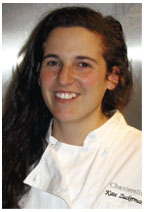May 14, 2003: Class Notes
Class Notes Profiles:
Science
fiction or science?
Michael Archer 67 attempts to clone extinct Tasmanian tiger
Sweet
endings
Kate Zuckerman 93 creates yummy desserts at posh New York restaurant
Email your class notes...many secretaries have email. Check our online Class Secretaries Directory.

Michael Archer ’67 attempts to clone extinct Tasmanian tiger
Michael Archer ’67, director of the Australian Museum in Sydney, lives by the maxim that museums should be safe havens for “dangerous ideas.” That philosophy reflects the project that is closest to his heart — the museum’s controversial attempt to clone the extinct Tasmanian tiger. Aiming to break new ground, Archer and his colleagues have been working for the past three years to reconstitute an animal using fragmented DNA harvested from dead cells. They hope to clone the tiger in about 10 years, using the Tasmanian devil as a host, and ultimately produce a viable population of Tasmanian tigers. “We don’t want a strange animal pacing back and forth in a laboratory. What we want to do is put that animal back in the wild,” says Archer, a biology professor at the University of New South Wales and a fellow of the Australian Academy of Science.
Archer’s Jurassic Park-style experiment has drawn its share of critics. Many scientists dismiss it as an impossible dream and a waste of money. One has called the project “the stuff of science fiction.” Other scientists are concerned with the ethical questions of cloning and “playing God.” To that, Archer says, “We played God when we inappropriately exterminated the Tasmanian tiger. What we are trying to do now is play ‘smart human’ by seeing if it’s possible to use technology to undo what we shouldn’t have done in the first place.”
Archer promotes his vision of an Australian “wildlife revolution” that he considers necessary to save the continent’s many endangered native species. Setting aside protected areas is noble but insufficient, he says. People need to support the harvesting of free-range native animals and plants to ensure that their populations won’t decline. And people should consider keeping native animals as pets as a means of conservation. A geology major at Princeton, Archer practices what he preaches. Ever since the dual American-Australian citizen was studying for his Ph.D. in zoology at the University of Western Australia in Perth, his unusual “house guests” have included marsupials such as swamp wallabies, rufous bettongs, and western quoll. He started taking in such animals when people brought him native animals that had been savaged by their cats.
In 1999 the Australian Museum launched the Future of Australia’s Threatened Ecosystems initiative, which is putting some of his ideas to the test. It aims to save ecosystems and also stimulate rural economies by encouraging private enterprises to harvest native flora and fauna instead of imported species. “By coming to depend on a native species that in turn depends on native habitat, conservation for all species gets a big win,” he says.
Decades spent leading research teams on paleontological expeditions
have given Archer an appreciation of the long-term view. Critics of his
vision of wildlife don’t ruffle him. If offending some environmentalists
and scientists is the price of eventual success, he can live with it.
Convincing people to try unconventional conservation approaches, he believes,
may be a matter of life or death. ![]()
By Luba Vangelova
Luba Vangelova is a freelance writer in Washington, D.C.

 Sweet
endings
Sweet
endingsKate Zuckerman ’93 creates yummy desserts at posh New York restaurant
Kate Zuckerman ’93 was sure her post-Princeton life would involve graduate school. She loved being an anthropology major and wanted to continue her studies, but she decided to take some time off after graduation first. When her musician boyfriend performed in Boston and then attended graduate school in San Francisco, she followed, cooking in the kitchens of high-end restaurants. By the time they married in 1996, her “time off” had become her vocation, and after a honeymoon in Europe, she stayed behind in Paris to do a stage — a traditional, grueling, French cooking internship.
Now, as the head pastry chef at the acclaimed New York restaurant Chanterelle, Zuckerman has combined her classic French technique with a new American interest in seasonal and regional produce. She chose her particular role in the kitchen in part for the family-friendly 7 a.m.—3 p.m. schedule it affords (she is the mother of two young children), but also for the challenge of creating desserts that satisfy the sweet tooth while complementing the rest of the meal. Patrons can find everything from warm chestnut amaretti pudding to honey crème fraîche parfait to creamy chocolate ganache.
“You can be really creative if you set yourself a bunch of limitations. That’s my philosophy,” says Zuckerman. “What limits me is each menu, which has four options” — offering one seasonal fruit, one light, one chocolate, and one frozen dessert. “I can only have so many in the oven, only so much space upstairs to distribute off the service station. With those para-meters, it’s really easy to come up with all sorts of ideas.”
Every month she creates four new desserts. Lightness is her signature, and she has created a range of fresh-fruit consommés that she garnishes with her original fruit chips — thin slices of apple, strawberry, pineapple, or rhubarb, poached in syrup and baked at a low temperature.
“But I also do lots of fun petits fours that are milk chocolate
and peanut butter,” Zuckerman says. “And a lot of soufflés.
They can be lemon, passion fruit, or chocolate. I love them. Everybody
loves soufflés. That’s one thing I learned in France.”
![]() By K.B.
By K.B.

